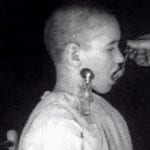 Weird Stuff
Weird Stuff  Weird Stuff
Weird Stuff  Our World
Our World 10 Ways Your Christmas Tree Is More Lit Than You Think
 Movies and TV
Movies and TV The 10 Coolest Stars to Set Sail on The Love Boat
 History
History 10 Things You Didn’t Know About the American National Anthem
 Technology
Technology Top 10 Everyday Tech Buzzwords That Hide a Darker Past
 Humans
Humans 10 Everyday Human Behaviors That Are Actually Survival Instincts
 Animals
Animals 10 Animals That Humiliated and Harmed Historical Leaders
 History
History 10 Most Influential Protests in Modern History
 Creepy
Creepy 10 More Representations of Death from Myth, Legend, and Folktale
 Technology
Technology 10 Scientific Breakthroughs of 2025 That’ll Change Everything
 Weird Stuff
Weird Stuff Ten Bizarre Facts About The Doge Meme
 Our World
Our World 10 Ways Your Christmas Tree Is More Lit Than You Think
 Movies and TV
Movies and TV The 10 Coolest Stars to Set Sail on The Love Boat
Who's Behind Listverse?

Jamie Frater
Head Editor
Jamie founded Listverse due to an insatiable desire to share fascinating, obscure, and bizarre facts. He has been a guest speaker on numerous national radio and television stations and is a five time published author.
More About Us History
History 10 Things You Didn’t Know About the American National Anthem
 Technology
Technology Top 10 Everyday Tech Buzzwords That Hide a Darker Past
 Humans
Humans 10 Everyday Human Behaviors That Are Actually Survival Instincts
 Animals
Animals 10 Animals That Humiliated and Harmed Historical Leaders
 History
History 10 Most Influential Protests in Modern History
 Creepy
Creepy 10 More Representations of Death from Myth, Legend, and Folktale
 Technology
Technology 10 Scientific Breakthroughs of 2025 That’ll Change Everything
10 Classic Horror Stories Inspired By True Events
The inspirations for famous writers’ horror stories are often as interesting (and horrific) as the tales themselves. Certainly, such is the case in regard to the chilling classics on this list, which were written by such heavyweights as Nathaniel Hawthorne, Edgar Allan Poe, Charles Dickens, Charlotte Perkins Gilman, Rabindranath Tagore, Sir Winston Churchill, Ray Bradbury, Daphne du Maurier, and Joyce Carol Oates.
10 “The Birthmark”
Nathaniel Hawthorne’s 1843 short story “The Birthmark” concerns a scientist, Almayer, who finds his wife Georgiana exquisitely beautiful except in one detail: her cheek, he believes, is marred by the presence of a birthmark in the shape of a miniature hand. He persuades her to drink a potion that he concocts, which causes the birthmark to fade completely, but, in the process of doing so, also kills her. The last two sentences provide the story’s theme: “Blinded by a meaningless imperfection and an impossible goal, Almayer had thrown away her life and with it his chance for happiness. In trying to improve his lovely wife, he had failed to realize she had been perfect all along.”
According to Patricia Dunlavy Valenti, author of the biography Sophia Peabody Hawthorne: 1809-1847, Hawthorne’s story was inspired by his own wife’s miscarriage: “Translated into fiction, the blood color of the birthmark . . . connotes female issue, whether that produced by menstruation or miscarriage, or as is in Sophia’s case, the one possibly confused for the other,” which, to Hawthorne, “encodes the sum of female ailments to include depraved sexuality and faulty reproductive capacity.”
9 “The Oblong Box”
Edgar Allan Poe’s 1844 short story “The Oblong Box,” recounts a sea voyage in which Cornelius Wyatt, his wife, and his two sisters reserve three rooms aboard the Independence. Wyatt and his wife, together with an “oblong box” reeking of a foul odor, occupy one of the rooms; his sisters occupy another. The third room, the narrator assumes, is either occupied by their servant or is used to store the travelers’ excess luggage. Although Wyatt’s wife is rumored to be a beautiful woman, the narrator observes that she is actually quite plain, when she leaves her husband alone in their room to spend the night in the third room. After the ship is lost during a hurricane, Wyatt refuses to join the crew and the other passengers in the vessel’s lifeboat, lashing himself to the box, instead, and drowns at sea.
During an encounter, a month afterward, the ship’s commander, Captain Hardy, explains the mystery of the box: it was a coffin; Wyatt, accompanied by his sisters, was traveling from Charleston, South Carolina, to New York City to return the body of his beautiful, late wife to her mother. To avoid disturbing the guests, the captain arranged for the box to be registered as baggage, and Wyatt’s maid had posed as his spouse.
Poe was inspired by a newspaper account, three years earlier, of John C. Colt’s murder of Samuel Adams, the brother of Samuel Adams, who manufactured the famous Colt revolver that proved equally popular among both nineteenth-century Wild West gunfighters and soldiers of the U. S. Army.
The murder occurred in 1841, as the result of “an unpaid bill.” After he had killed Adams, the murderer had packed his victim’s corpse in a box of salt, shipping it to New Orleans, Louisiana. After Adams’s friends notified authorities that he had gone missing, the box was found aboard the ship. The stench of the decomposing body, crew members said, had been mistaken “for rat repellent.”
8 “The Signal-man”
Charles Dickens’s 1866 short story, “The Signal-man,” is a gripping horror story based on the Clayton Tunnel Crash. A signal-man stationed at a remote location near a tunnel tells the narrator that he hears bells, warning him of imminent danger, just before a phantom appears, heralding a horrific crash. On one such occasion, the narrator is present. Not hearing the warning bells the signal-man hears, the narrator believes that the signal-man is hallucinating. Finally, the signal-man himself is struck and killed by an oncoming train, after failing to heed the engineer’s repeated warnings to him to step clear of the track.
Reports of the Clayton Tunnel Crash, which occurred on August 25, 1861, five miles from Brighton, the seaside resort on England’s southern coast, inspired Dickens’ story, as may have his own experience, four years later, on June 9, as the survivor of a train wreck. He was traveling with his mistress Ellen Ternan and Ternan’s mother, when their train derailed at Staplehurst, a village in Kent, England.
A sketch in a 1965 edition of The Illustrated London News shows the wreck. Cars toward the rear of the train separated from those toward the front, several of which fell from a viaduct, breaking and splintering, as the train was crossing the trestle. The locomotive leans precariously over the side of the trestle, propped up by a thick timber, as officials and spectators watch laborers clear the wreckage.
Having survived the accident, Dickens rendered assistance to the injured, some of whom died in his presence. Ten people did not survive the incident, and 49 others were injured. The author then returned to the wreckage to retrieve the manuscript of his novel Our Mutual Friend. He related the ordeal “in a letter . . . to his old schoolfriend [sic] Thomas Mitton.”
The wreck seems to have resulted from several causes. The train was traveling downhill at fifty miles per hour; rails on the viaduct had been removed during repair work; “the foreman in charge of the construction site had consulted the wrong time-table, and he did not expect Dickens’s train for another two hours”; and the position of the flagman, who’d been stationed with a red flag to warn the engineer of the need to stop, was, “against regulations,” too near the viaduct to allow the train to stop in time. The accident left an indelible impression upon the author. Dickens wrote, “I have sudden vague rushes of terror, even when riding in a hansom cab, which are perfectly unreasonable but quite insurmountable.”
7 “The Yellow Wallpaper”
“The Yellow Wallpaper,” an intense 1892 horror story, is regarded as an early feminist declaration of independence and autonomy. The protagonist, a woman confined to a bed in an otherwise empty room, the walls of which are covered in yellow wallpaper, slowly loses touch with reality. Her husband, a doctor, and her brother-in-law, also a physician, concur that bed rest is the best treatment for her “temporary nervous depression” and its attendant “hysterical tendency.” She does not seem to be as certain but she follows the recommended treatment of “phosphates or phosphites . . . and tonics, and journeys, and air, and exercise,” forgoing any and all work.
Alone in the room, with nothing to do, she studies the yellow wallpaper, finding it “dull,” confusing, and full of “uncertain curves” and contradictory, “outrageous angles.” The color is “repellent” and “horrid” to her.” Eventually, she discerns a “faint figure” behind the wallpaper, a woman who may provide her with the means of escaping her confinement and her husband’s stifling care.
In a 1913 article in The Forerunner, Perkins explained why she wrote “The Yellow Wallpaper,” describing her postpartum depression, as “a severe and continuous nervous breakdown tending to melancholia—and beyond.” In 1887, three years into her depression, “a noted specialist in nervous diseases” advised her to “have but two hours’ intellectual life a day, [and] never to touch pen, brush, or pencil again.”
For three months, she followed the doctor’s orders, which nearly cost her her sanity, before she got out of bed and resumed work, a self-prescribed therapy that she believed saved her. Thankful for her “narrow escape” from insanity, she wrote “The Yellow Wallpaper” in the hope of sparing other women “from a similar fate,” that of madness, that had almost claimed her.
After reading her story, the doctor who’d prescribed bed rest for her “admitted to friends of his that he had altered his treatment of neurasthenia.” Unfortunately, other doctors were not convinced by the story. “A Boston physician” protested that Perkins’s “story ought not to be written [since] . . . it was enough to drive anyone mad to read it,” and a Kansas doctor described her narrative as “the best description of incipient insanity he had ever seen.”
6 “Hungry Stones”
Rabindranath Tagore’s chilling 1895 ghost story “The Hungry Stones” is based on his having stayed, as a teenager, at a former palace in Shahinag, near Ahmedabad, Gujaret, India, which is located along the Sabarmati River. As a guest in the palace, he “imagined how it might have been” during the old days, when it was “in full swing.”
The result of his imaginative re-creation of the palace in its heyday is his masterful story, in which a young tax collector, Srijut, stays in a remote palace that, he believes, is haunted by the spirits of its past occupants, including the ghost of a beautiful young woman. The story mixes everyday reality with supernatural elements, as the palace’s past mingles with Srijut’s present.
Karim Khan, a clerk among the tax collectors, summarizes the secret and the power of the palace: its ghosts, victims of “unfulfilled desire and demented lust,” cause “every block of stone” to hunger and thirst, due to “the curse of [the ghosts’] anguished and frustrated longing,” as the spirits, “like ravening demons,” seek endlessly to “devour” anyone who comes “within their grasp.”
5 “Man Overboard”
In 1898, long before he was knighted by Queen Elizabeth II in 1953, Winston Churchill wrote “Man Overboard,” a taut story of ironic suspense, a draft of which he shared with General Ian Hamilton, hoping the tale might “amuse” him.
A passenger aboard a mail steamer on its way through the Red Sea falls overboard after he leaves a concert underway in the ship’s companion-house to smoke a cigarette and leans against an “insecurely fastened rail.” Although he makes “a great splash,” no one hears him, nor, over the music, does anyone discern his screams for help. As the steamer continues on its way, putting greater and greater distance between itself and the man overboard, the protagonist, becoming exhausted, despairs. Unable to put an end to his plight by drowning himself, as he’d hoped, he finally prays to God for assistance. The answer to his prayer is not only ironic, but also both unexpected and apt. The story was illustrated by Henry Austin.
As an article concerning the story observes, Churchill himself was a frequent passenger on ships that traveled back and forth across the Red Sea “en route or returning from India or South Africa,” and, during these trips, he might well have imagined “the possibility of falling overboard.” The terror of such an experience was something he knew firsthand, as a result of an incident that happened to him as a youth, historian Andrew Roberts points out.
During a “boyhood adventure on Lake Geneva,” with his brother Jack, the siblings jumped off their rowboat to swim. The boat, caught in a “light breeze,” was blown farther and farther from the boys, and “young Winston himself had felt the sensation when a boat pulls away,” as he realized that “no help was near,” that he and Jack were “unaided” and might “never reach the shore.”
He began to swim in earnest, “for life,” and he was able to reach the boat and return for Jack. In recalling the incident in his autobiography, Churchill wrote, “I saw Death as near as I believe I have ever seen him.” His feelings are reflected in the character of the man overboard.
4 “Summer Night”
Although Ray Bradbury’s suspenseful 1947 mystery “Summer Night” does not appear to be in print nowadays, it is the basis of a short film of the same title, which was broadcast on July 15, 1948, on the Suspense television show. In the film, starring Ida Lupino, Anna is initially unable to get a telephone call through to her friend Helen. During the panic that ensues the news that The Lipstick Killer is on the prowl after having killed two victims; the operator has “trouble connecting the call.” Terrified, Anna wants company, even though she and Helen “haven’t spoken for four years.” Agreeing to keep Anna company, Helen arrives at Anna’s house, only to discover just “how much stranger Anna has become since she last saw her.”
Bradbury’s original story was inspired by two horrific murders, that of Elizabeth Short, the “Black Dahlia,” and that of Jeanne French, whose case became known as the “Red Lipstick Murder.” In Bradbury’s story, the suspect is known as the “Lipstick Killer,” and his signature is a mark that he writes on their corpses, using orange lipstick.
On January 15, 1947, during a walk with her child in a Los Angeles, California, neighborhood, a mother stumbled upon the remains of a woman whose body had been cut in half at the waist. The Federal Bureau of Investigation matched fingerprints sent by the Los Angeles Police Department to those of 22-year-old Elizabeth Short, whom the local press subsequently nicknamed “The Black Dahlia,” based on Short’s fondness for sheer black attire and the Blue Dahlia movie then showing in theaters.
According to a “special” edition of the Daily Police Bulletin, issued on January 21, 1947, she was last seen exiting a car at the Biltmore Hotel. A friend of men and women alike, she frequented “cocktail bars and night spots.” Her murderer was never identified or captured.
On February 1, 1947, the body of Jeanne French was discovered. After marrying four times, the 44-year-old woman, who’d worked as both a nurse and a pilot, disappeared in Los Angeles—until construction worker H. C. Shelby discovered her naked, brutalized body near “a pile of women’s clothing.” Savagely beaten and stomped, she’d bled to death. Her killer had used her lipstick to leave the police a vulgar message, “F*CK YOU, P.D,” which he’d signed “Tex.” The press had misread the message, though, reporting “P. D” as “B. D.,” which caused many reporters to associate her murder with that of Short, the Black Dahlia, who’d been killed only three weeks before. As was the case with Short, despite various theories as to who killed French and why, her killer was never identified.
3 “The Veldt”
Another of Bradbury’s tales, “The Veldt,” first published in 1950, focuses on 10-year-old siblings Peter and Wendy Hadley, whose hi-tech nursery allows them to set up 3-D biomes. Although their parents George and Lydia fear that the children are devoting too much time to one of the imaginary worlds they create, George argues that the artificial worlds aren’t a threat. However, the children are in a battle of wills against their parents, waging what critic Lahna Diskin characterizes as an “insidious struggle for total power and control . . . behind the facade of innocence,” in which Peter and Wendy’s “psychological alienation has produced the reality of Africa,” their versions of the veldt becoming increasingly wilder and more ferocious. George and Lydia have plenty to fear, the story’s conclusion implies.
As the children’s names suggest, Diskin adds, the source of Bradbury’s story is likely to be James Barrie’s play Peter Pan. “In both works of fiction, Wendy and Peter are devotees of [a timeless] never-never land, a dimension . . . beyond the constraints and conventions imposed on demanding, if not persecuting, adults,” although, unlike the children in Peter Pan, “in ‘The Veldt,’ Wendy and Peter go beyond the point of no return. The vengeance they wreck [sic] on their parents leaves them unaffected and undisturbed,” and the children experience neither “remorse [nor] guilt,” but reveal themselves as being “holy terrors for whom expediency and self-preservation are the sole dictates of behavior.”
2 “The Birds”
Published in 1952, “The Birds” takes place in Cornwall, in South West England, Daphne du Maurier’s hometown for most of her life. After a farmer is attacked by seagulls, the birds’ “kamikaze attacks” become increasingly fierce and cover larger and larger areas, until “it has become clear that all of Britain is under aerial assault.” The story’s horrors are intensified as Nat Hocken, a farmhand, tries to protect his family, he discovers his neighbors’ bodies after the birds’ attacks, and military aircraft appear insufficient to stem the tides of the birds’ assaults. The story has political overtones, since “the east wind is implicated in the birds’ attacks,” suggesting the Soviet and Chinese aggression against England near the end of the 1940s and during the Cold War.
1 “Where Are You Going, Where Have You Been”?
Joyce Carol Oates’s story 1966 “Where Are You Going, Where Have You Been?” was inspired by the horrific deeds of serial killer Charles Schmidt, the Pied Piper of Tucson. Many of Oates’s killer Arnold Friend’s habits and bizarre behaviors are similar or, in some cases, identical to those of Schmidt. Both are charismatic, stuff their shoes with newspaper to increase their height, listen to rock and roll, and prey on teenage girls. As Oates herself observed, Schmidt “mimicked teen-agers in their talk, dress and behavior, but he was not a teen-ager.” Her story, she said, is a “realistic allegory,” in which Connie, “an innocent young girl[,] is seduced by way of her own vanity; she mistakes death for erotic romance of a particularly American/trashy sort.”
Schmidt murdered three girls, 15-year-old Alleen Rowe; his girlfriend Gretchen Fritz, who threatened to inform on him to the police after he’d confessed his murder of Rowe to her and the couple had fought; and Fritz’s 13-year-old sister Wendy, who “just happened to be at the wrong [place] . . . at the wrong time.” Convicted, Schmidt later escaped from prison, but he was captured and returned, this time to be stabbed by two of his fellow prisoners. He died twenty days later, on March 30, 1974, at age thirty.








